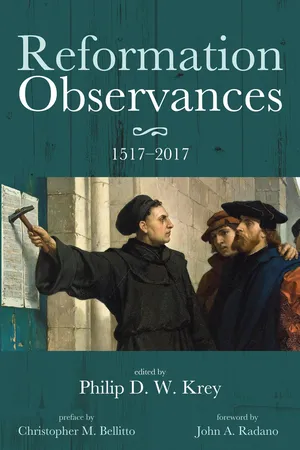![]()
1
Martin Luther and the Lutheran Reformation—October 31, 1517–October 31, 2017
From Augustinian Monk and Doctor of the Church Attempting to Reform Catholic Theology in 1517 to doctor communis of the Church in 2017
—Philip D. W. Krey
1517 The “Posting” of the Ninety-Five Theses and Early Commemorations
We may never know whether on October 31, 1517, Martin Luther actually nailed or had a student nail ninety-five theses on the door of the Castle Church or on other Wittenberg church doors. We do know that his colleague and friend Philipp Melanchthon, who arrived in Wittenberg one year later, thought he did. In a vita about Luther in the preface to the second Wittenberg edition of Luther’s Works (1546) he noted that having been spurred on by Tetzel’s preaching and sale of indulgences Luther nailed the Ninety-Five Theses on the door of the Castle Church on October 31, 1517. Luther’s colleague also “held a classroom ceremony for the event out of collegial piety.” Martin Luther himself seems to have celebrated the event at home on November 1, 1527, as he reports in a letter to Nikolaus von Amsdorf: “Ten years after the indulgences have been destroyed; in memory of this we both drink and are comforted at this hour.” However, there is no mention of his having observed the event in subsequent decades. What we do know is that these Ninety-ive Theses intended as a proposal for reform by “an intentionally Catholic theologian” who knew himself to be a teacher of the church via theological discussion launched a movement when published that eventually divided the church and perhaps the late-medieval and modern worlds. Those divisions are healing after five hundred years and his reform theology is now gradually being accepted as part of the Roman Catholic tradition such that the 500th Anniversary Celebration of the Reformation will observe him more as the common doctor of the church than hero and prophet.
We know that Luther’s critique of scholastic theology and his theological concerns with indulgences began earlier than the evening and the day of All Saint’s (October 31–November 1) 1517, but this weekend has been etched into the historical imagination over the centuries that this essay will address. Scholars have proposed that Martin Luther’s reform can now be understood as the most significant in a series of medieval and late-medieval attempts at reform. In some sense the Roman Catholic Church had become immune to the many attempts at reform from, for example, the Mendicant movements of the thirteenth century that were received by Pope Innocent III to the failed reforms of the Conciliar movement of the fifteenth century that foundered on the reefs of nationalism and a timeless attraction for a strong leader over against a constitutional and balanced papal monarchy. In any event, in the sixteenth century the context left Luther, the Augustinian monk and young professor of theology at the University of Wittenberg, with a proposal for reform and a number of secret sympathizers but a hardened church structure that made dialog impossible. He was eventually declared a heretic.
What happened on that critical day? The Augustinian monk and young professor at the University of Wittenberg (age 34), Dr. Martin Luther sent a letter to the Archbishop of Magdeburg–Mainz alerting him of the danger to the proclamation of the Gospel in his territory since the Dominican Friar Johann Tezel was marketing and exaggerating the sale of indulgences. To this letter Luther attached theses arguing theologically against the sale of indulgences. He did not expect the Prince-Bishop to respond to the theses, as the disputation was the right and duty of the university. Thus Luther was working on this issue for some time. The Wittenberg faculty including Andreas Karlstadt was preparing for theological debate. Luther had been researching the ecclesiastical, theological, and legal grounds for indulgences earlier in 1517 and was distressed by the great collection of relics that Prince Frederick had stored at the Castle Church—the list of which would be read publicly on All Saints Day, November 1. Historians agree that whether or not the Theses were posted, the events of the days lose none of their historical importance. To some extent Luther was surprised by the broad reception that the Theses received. That the subsequent sermon “On Indulgences and Grace” (Feb. 2, 1518) in German enjoyed at least twenty editions surprised Luther. What was and remains decisive is the Reformation’s proposal to the church catholic, a proclamation of the gospel that continues to challenge and influence Lutheran, Reformed, and Roman Catholic Christians to this day.
What we also know is that as the Reformation movement developed the nailing of the Theses was not the focus of commemorations but the life events of Martin Luther himself—his birth and death dates—and the anniversaries of key Reformation events—the establishment of Lutheranism in different territories, the Diet of Augsburg, or the Book of Concord. To some extent the date and event itself was lost to history for a century and the message was overshadowed by the larger than life figure of Luther, himself and the movement that the content of the theses set in motion.
Given the context of the church and personalities involved, the movement that was launched, in particular, by the mailing of the Theses and later explanations unleashed forces that were irreversible and hurtled towards schism and not for the Wittenberg faculty’s hoped for theological discussion. Tetzel felt compelled to respond and Eck took it upon himself to challenge Luther. Given that Luther himself was soon considered a “prophet teacher and hero” by his followers the anniversaries of his ...
